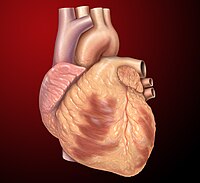
Photo from wikipedia
Myocardial ischemia culminates in ATP production impairment, ionic derangement and cell death. The provision of metabolic substrates during reperfusion significantly increases heart tolerance to ischemia by improving mitochondrial performance. Under… Click to show full abstract
Myocardial ischemia culminates in ATP production impairment, ionic derangement and cell death. The provision of metabolic substrates during reperfusion significantly increases heart tolerance to ischemia by improving mitochondrial performance. Under normoxia, glutamate contributes to myocardial energy balance as substrate for anaplerotic reactions, and we demonstrated that the Na+/Ca2+ exchanger1 (NCX1) provides functional support for both glutamate uptake and use for ATP synthesis. Here we investigated the role of NCX1 in the potential of glutamate to improve energy metabolism and survival of cardiac cells subjected to hypoxia/reoxygenation (H/R). Specifically, in H9c2-NCX1 myoblasts, ATP levels, mitochondrial activities and cell survival were significantly compromised after H/R challenge. Glutamate supplementation at the onset of the reoxygenation phase significantly promoted viability, improved mitochondrial functions and normalized the H/R-induced increase of NCX1 reverse-mode activity. The benefits of glutamate were strikingly lost in H9c2-WT (lacking NCX1 expression), or in H9c2-NCX1 and rat cardiomyocytes treated with either NCX or Excitatory Amino Acid Transporters (EAATs) blockers, suggesting that a functional interplay between these transporters is critically required for glutamate-induced protection. Collectively, these results revealed for the first time the key role of NCX1 for the beneficial effects of glutamate against H/R-induced cell injury.
Journal Title: Scientific Reports
Year Published: 2017
Link to full text (if available)
Share on Social Media: Sign Up to like & get
recommendations!